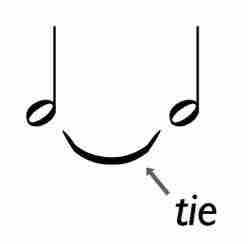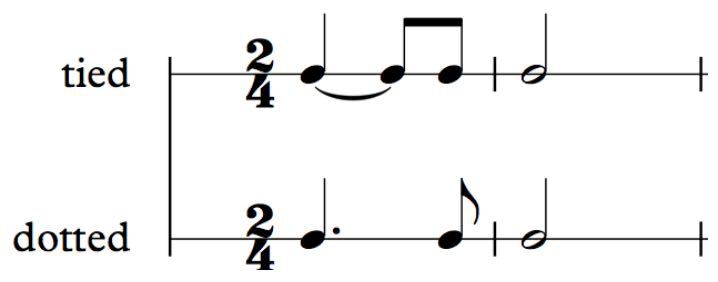Day 7: Adding Duration With The Tie
Although the dot is useful to increase the duration of note values, it is also limited because, as we’ve seen, it increases the duration of the note specifically by half its original value
.
A more flexible means of adding to the duration of a note is by tying it to another note. A tie is a curved line strung between 2 notes. The tied note is not struck, played or sung again; instead, its duration is added to the original so that it is prolonged.
Here’s an example of a simple rhythm without ties.
Now, here it is with a tie. Listen to how the tied note is not played again but its duration is added unto the first note instead.
The tie is useful in 3 particular cases:
1. Adding notes together over a bar line:
Since it is not possible to have note durations longer than one full measure in any meter, we can use the tie to create longer notes. In the example here, the meter is in 3, but thanks to the tie, the note is 6 quarter notes long–the equivalent of 2 full measures in this meter.
The tie adding notes together over a bar line
2. Adding notes together to produce a specific duration:
Often we might need to have a note duration that is not possible using standard note values only. In the first example below, the resulting duration is of a quarter note plus a sixteenth. There is no way of notating such a note value other than with the tie. The same goes for the second example. There’s no way of notating the specific duration of a half note plus an eighth note except with the tie.
The tie adding notes together to produce a specific duration
3. Adding 3 or more notes together:
The tie is not limited to 2 notes. It can be used over as many notes or measures as are needed. In this example, we have a long note made up of three notes tied together:
The tie adding 3 or more notes together
It is interesting to see that dotted notes can be written also as tied notes. These 2 rhythms on the right sound exactly the same! We still use dotted notes, however. They are standard practice, and musicians are used to them. Musical notation also tends to be less cluttered using dots instead of ties when possible.
In theory, dotted notes can be written as tied notes.







